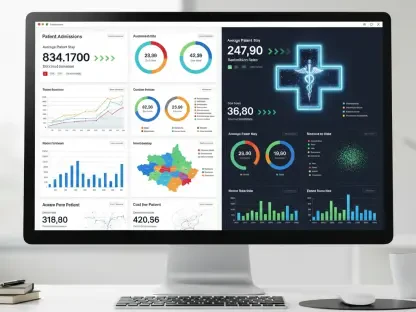The healthcare industry stands at a transformative juncture where artificial intelligence (AI) is redefining clinical practices, particularly in nursing. Recent data reveals that AI adoption in healthcare settings has surged by over 30% in the last two years, with tools designed to streamline workflows and enhance patient care becoming commonplace. This rapid integration raises a critical question: how does AI reshape the role of nurses, who remain the backbone of compassionate care? Far from replacing these essential professionals, AI emerges as a powerful ally, promising to augment their capabilities while preserving the human touch that defines nursing.
The Role of AI in Modern Healthcare
Current Landscape and Significance
AI’s presence in healthcare has grown remarkably, with hospitals and clinics increasingly relying on advanced algorithms to support diagnostics, treatment planning, and administrative tasks. Major players like IBM, Google Health, and Microsoft are driving innovation through platforms that analyze vast datasets, offering insights that were once unimaginable. Key applications include image recognition for radiology, predictive models for patient outcomes, and virtual assistants for scheduling, all of which are becoming integral to clinical environments.
Beyond specific tools, the significance of AI lies in its ability to handle repetitive or data-intensive tasks, freeing up time for healthcare professionals to focus on direct patient interaction. This shift is particularly evident in resource-strained settings where efficiency can mean the difference between timely care and critical delays. The momentum behind AI adoption signals a broader trend of digital transformation, positioning technology as a cornerstone of modern medical practice.
Impact on Nursing as a Profession
For nurses, AI introduces a dual dynamic of automation and empowerment through tools that assist with documentation, medication tracking, and even early warning systems for patient deterioration. These innovations reduce the burden of mundane tasks, allowing nurses to dedicate more energy to bedside care and emotional support. Decision-support systems, for instance, provide evidence-based recommendations, enhancing clinical judgment without undermining professional autonomy.
The broader implications of this technological shift touch on workforce dynamics, as nurses adapt to new skill requirements and collaborative models with tech systems. Patient outcomes also stand to improve, with AI-driven insights enabling faster interventions and personalized care plans. However, the integration of AI must be carefully managed to avoid over-reliance on machines, ensuring that nurses remain central to care delivery.
Enhancing Nursing with AI: Opportunities and Trends
Key Innovations and Emerging Tools
Cutting-edge AI technologies are reshaping nursing through predictive analytics that forecast patient risks, such as falls or infections, enabling proactive measures. Documentation automation tools, powered by natural language processing, convert spoken notes into structured records, slashing administrative time. Clinical decision support systems further stand out by offering real-time guidance on complex cases, acting as a virtual second opinion for busy professionals.
Emerging trends point toward personalized care, where AI tailors treatment suggestions based on individual patient data, enhancing precision in nursing interventions. Remote monitoring systems, another growing area, allow nurses to track vital signs from afar, ensuring continuous oversight for chronic or post-discharge patients. These advancements collectively boost efficiency, letting nurses manage larger caseloads without compromising quality.
Growth Potential and Adoption Rates
Market projections indicate a robust trajectory for AI in healthcare, with estimates suggesting a compound annual growth rate of 37% from this year to 2030. Adoption rates are climbing, especially in urban hospitals and academic medical centers, where over 60% of facilities report using at least one AI tool in clinical workflows. This rapid uptake reflects both technological maturity and a growing trust in AI’s reliability among healthcare providers.
Looking ahead, AI tools are expected to evolve with greater integration into wearable devices and electronic health records, streamlining data flow for nurses. Expansion into rural and underserved regions also holds promise, potentially bridging care gaps through telehealth and AI-driven triage systems. Such developments underscore a future where technology amplifies nursing reach and impact across diverse settings.
Challenges in Integrating AI into Nursing Practice
The path to AI integration in nursing is not without obstacles, as technological limitations often hinder seamless deployment in fast-paced environments. Resistance to change among staff, rooted in unfamiliarity or fear of job displacement, poses another barrier, necessitating robust training programs. Ethical concerns also loom large, particularly around data security and the risk of algorithmic bias affecting patient care decisions.
Systemic challenges further complicate the landscape, as AI cannot address deep-rooted issues like unsafe staffing levels or workplace violence that plague many healthcare facilities. These problems demand policy-level solutions beyond technology’s scope, highlighting the need for a balanced approach. Thoughtful integration strategies, including pilot programs and stakeholder engagement, are essential to align AI tools with real-world nursing needs.
Moreover, the financial burden of adopting AI systems can strain budgets, especially for smaller institutions lacking the resources of larger counterparts. Overcoming this requires innovative funding models and partnerships to ensure equitable access. Addressing these multifaceted hurdles will determine how effectively AI can support nurses without disrupting established care frameworks.
Ethical and Regulatory Considerations for AI in Nursing
The ethical dimensions of AI in healthcare demand careful scrutiny, especially concerning patient privacy, as vast amounts of sensitive data fuel these systems. Ensuring accountability remains paramount, with nurses needing to retain oversight over AI recommendations to prevent errors or misuse. The potential for depersonalized care also raises questions about maintaining the empathetic core of nursing amid technological intervention.
Regulatory frameworks are evolving to keep pace with AI’s rapid advancement, with mandates focusing on transparency and compliance to safeguard patient rights. Bodies like the Food and Drug Administration are setting standards for AI medical devices, requiring rigorous validation before clinical use. These regulations aim to balance innovation with safety, ensuring equitable implementation across diverse healthcare settings.
A critical need exists for standardized guidelines that address bias in AI algorithms, which could disproportionately affect marginalized groups if left unchecked. Collaboration between policymakers, tech developers, and nursing leaders is vital to craft rules that prioritize fairness. Such efforts will shape an ethical landscape where AI enhances care without compromising trust or integrity.
The Future of AI and Nursing: Collaboration Over Replacement
Envisioning the future, AI and nursing are poised for deeper collaboration, with technology serving as a partner rather than a substitute for human expertise. Innovations like AI-powered robotics for routine tasks and advanced chatbots for patient education are on the horizon, promising to further lighten nurses’ workloads. These tools aim to complement skills, not overshadow them, preserving the personal connection central to care.
Potential disruptions, such as workforce shifts or over-automation, must be navigated with caution to avoid diminishing the nurse’s role. Global healthcare trends, including aging populations and rising chronic disease rates, underscore AI’s value in scaling care delivery, but only with active nurse input in design and deployment. Their frontline perspective is crucial to tailoring technology to practical, patient-focused applications.
Ultimately, the trajectory of AI in healthcare hinges on fostering a symbiotic relationship where nurses guide tech evolution. This collaborative ethos ensures that emerging tools align with clinical realities and cultural nuances across regions. Embracing this model positions the industry to harness AI’s full potential while safeguarding the essence of nursing.
Conclusion: Balancing Innovation with the Heart of Nursing
Reflecting on the insights gathered, it becomes evident that AI stands as a transformative force in healthcare, enhancing nursing efficiency and patient outcomes through targeted support. The journey of integration reveals both remarkable opportunities and persistent challenges, from technological adoption to ethical dilemmas, all of which shape a nuanced understanding of AI’s role.
Moving forward, actionable steps emerge as critical, including investing in nurse-led training initiatives to build tech proficiency and advocating for policies that address systemic healthcare issues alongside AI deployment. Establishing collaborative forums where nurses, developers, and regulators co-create solutions offers a promising path to ensure technology serves human needs.
The final consideration points toward a sustained commitment to patient-centered principles, urging stakeholders to prioritize empathy and equity in every innovation. By championing nurse leadership in this digital era, the healthcare sector can harmonize cutting-edge tools with the timeless compassion that defines nursing, paving the way for a balanced and impactful future.









